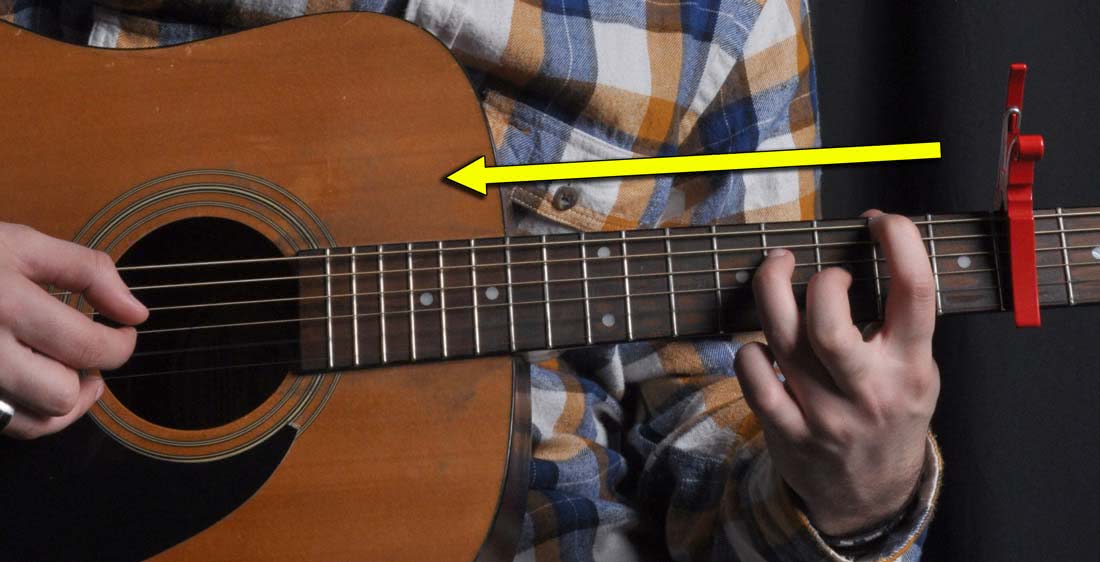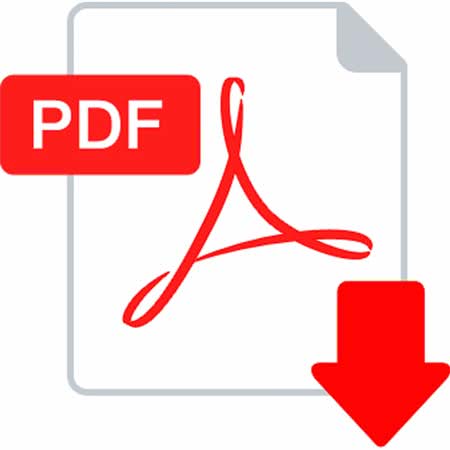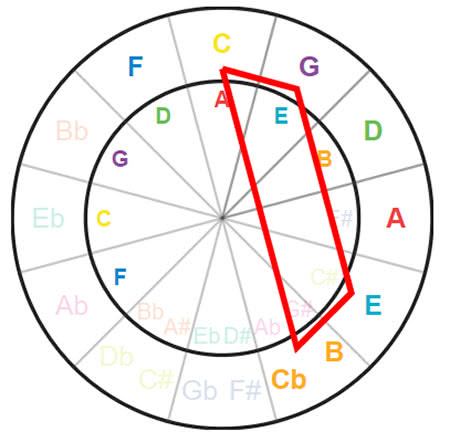Transpose Guitar Chords
How to Transpose Songs To Another Key
In this tutorial, we're going to learn how to transpose any song to any key, a useful skill to have, especially when making music with other people.
Transposing music involves the moving of a musical pitch up or down, but remaining in the same interval.
Here below is a tool that allows you to transpose chords up or down a number of half-steps:
How To Transpose Chords - Introduction
There are a few reasons as to why we would need to transpose notes or chords in our music, and the main reason is to change the key of a song .
If you have trouble singing in the key of Bb, you may try and transpose it to the Key of C to make it easier to sing.
We will sometimes transpose music to make it easier to play, for example the key of Eb is not the easiest for beginning guitarists , as there are no open chords .
There are also times where you will be playing a song that may not sound "right" in that case transposition may help.
Whatever your reasons, there are a few ways to go about transposing your music.
When dealing with song transposing, is always helpful to know as many as possible chord voicings; in our Chords Domination ebook you'll find more than 800 chord fingerings along all the fretboard.
Find The Key
Before you can start transposing you have to know what key you are in, often the first chord of the song is the key.
This is not always true, and if not you will have to take a look at the other chords present in the song to get an idea of the key.
If you are trying to find the key of a song by ear, well they have software to help, but in general it will be a matter of trial and error.
After you have found the key you are in, next you have to figure out which key you have to transpose to. If you have trouble playing a song in Eb, perhaps moving it to the key of G will make it easier.
How To Find The Key
Finding the key of a song is basically a trial and error approach, but you can identify some chords and check what key they fit (refer to the Nashville Numbers table below).
Many songs begin and end with the chord that matches the key of the song , but always keep in mind that this rule is not set in stone.
| Key | I | ii | iii | IV | V | vi | vii |
|---|---|---|---|---|---|---|---|
| C | Dm | Em | F | G | Am | Bm/b5 | |
| G | Am | Bm | C | D | Em | F#m/b5 | |
| F | Gm | Am | Bb | C | Dm | Em/b5 |
Here are some examples:
- The chords progressions of your song is the key is C major
- A songs with the chord progressions is likely in G major key
- Your songs is composed of the chords then the song is in F major key
How to transpose guitar chords with capo

Capo placed on the fretboard. With a capo you can raise the key pitch of a song without the need to change the chords fingering. It works like an index finger that does a 6 strings bar chord on the same frets
The capo is the easiest and most common method most guitar players use to shift their chords to another key.
Remember that barre chord shapes are easily movable , if you have a barred F chord and you wish to play a G , you only have to move that position up two frets.
That same F chord shape moved a whole step or two frets up gives you a G chord.
Now the capo takes the place of our barring index finger allowing us to have more ability to make the same chord shapes.
- Song chords in the original key:
- Placing the capo on the 2nd fret, we raise the pitch of the song by 1 whole-step
- Transponsed song chords:
- The chords fingerings do not change, it's like tuning your guitar 1 whole-step higher!
Imagine you are playing the normal chords of G, C, and D in a song, but let's say you want to be in the key of A.
By placing a capo on the second fret we can play those same chord shapes of G, C, and D, but this time the chords will be A, D, and E .
Very simple, in fact the capo is great for folks who don't want to bother with figuring out the transposition and need an easy fix.
Stringed instrument players , like guitarists, have capo abilities, many instruments out there don't get so lucky
Shifting Key Without a Capo
There are limitations with a capo, especially as you move up past the 8th fret . The voicing's start to get too high and the frets are closer together making it harder to do chord shapes.
Plus, if you ever find yourself without a capo, it is good to know other methods of shifting the key.
It is a rather easy process even without much understanding of music theory.
If we want to switch from the key of C to G , we simply count. Start with the chord progression of
The distance between the C and G keys is 7 half-steps (remember: 1 half-step = 1 fret on the fretboard)
- to move the C to G we go up seven half-steps: C -C#-D-D#-E-F-F#- G
- So next we move the F seven half-steps up (F to C): F -F#-G-G#-A-A#-B- C
- And then the G seven half-steps up (G to D): G -G#-A-A#-B-C-C#- D
If you know the name of the notes on the fretboard , you can visualize the process on the neck.
Simply you shift the root notes of your chords 7 frets higher (C to G, F to C, G to D)

Transposing from C to G key (7 frets up)
Now we have the chord progression of transposed to the key of G with .
If we want to make it even easier, we can simply refer to the table below (that show the chords for all the major keys)
Chords in Major Keys
| Key | I | ii | iii | IV | V | vi | vii |
|---|---|---|---|---|---|---|---|
| C | Dm | Em | F | G | Am | Bm/b5 | |
| G | Am | Bm | C | D | Em | F#m/b5 | |
| D | Em | F#m | G | A | Bm | C#m/b5 | |
| A | Bm | C#m | D | E | F#m | G#m/b5 | |
| E | F#m | G#m | A | B | C#m | D#m/b5 | |
| B | C#m | D#m | E | F# | G#m | A#m/b5 | |
| F# | G#m | A#m | B | C# | D#m | E#m/b5 | |
| C# | D#m | E#m | F# | G# | A#m | B#m/b5 | |
| Cb | Dbm | Ebm | Fb | Gb | Abm | Bbm/b5 | |
| Gb | Abm | Bbm | Cb | Db | Ebm | Fm/b5 | |
| Db | Ebm | Fm | Gb | Ab | Bbm | Cm/b5 | |
| Ab | Bbm | Cm | Db | Eb | Fm | Gm/b5 | |
| Eb | Fm | Gm | Ab | Bb | Cm | Dm/b5 | |
| Bb | Cm | Dm | Eb | F | Gm | Am/b5 | |
| F | Gm | Am | Bb | C | Dm | Em/b5 |
With a simple chart like this transposing becomes a breeze.
Take the chord progression in the key of C, and transpose it to the key of A.
By following the chart above those same chords transposed to A will be . (It's not cheating to keep a table like this handy in your practicing area, it saves time!)
| Key | I | ii | iii | IV | V | vi | vii |
|---|---|---|---|---|---|---|---|
| C | Dm | Em | F | G | Am | Bm/b5 | |
| A | Bm | C#m | D | E | F#m | G#m/b5 |
Chords In Keys Pdf To Download
 You can download these chords in keys tables in pdf format: we have created a music cheat sheet with all
the chords for each music keys
(major and harmonic minor) and the
sharp/flats patterns shown
following the circle of
fifths.
More details here
.
You can download these chords in keys tables in pdf format: we have created a music cheat sheet with all
the chords for each music keys
(major and harmonic minor) and the
sharp/flats patterns shown
following the circle of
fifths.
More details here
.
If you are already a subscriber of the newsletter , you should have received the link to your download area in your email box.
Using the Circle Of Fifths
 To transpose songs, you can also use the Circle Of Fifths, an awesome music theory device that embeds
tons of music knowledge in one simple circle
.
To transpose songs, you can also use the Circle Of Fifths, an awesome music theory device that embeds
tons of music knowledge in one simple circle
.
If you master the Circle Of Fifths hidden secrets it will be much easier to transpose songs, but also compose new tunes , build chords, manage keys, and more.
Learn more with our Circle Of Fifths tutorial and interactive tool .
Chords type does not change!
Luckily for most guitar playing we will rarely ever get more complicated than what we have seen so far.
If you have a more complex chord like Cm7, you follow the same rules as above.
Switching that chord to the key of G we do nothing with the minor 7th and just move the C five steps up to G.
The root chord or note is all we ever worry about when transposing.
Transposing Slash Chords
Sometimes transposing may require you to write it down on a piece of paper or counting on your fingers, but it does not involve complicated math.
Let's say we have a G/B chord , remember a slash chord implies a different bass note.
Normally a G chord has a G for a bass note, but here we have a B.
If we want to change that to the key of C it will be C/E , the G moves 5 half-steps (or frets) up to C and the B moves 5 half-steps up to E.
You can always use the fretboard as a counting device, simply shift your notes by 5 frets higher and you'll find the transposed notes.

To transpose the G/B chord to C/E, we simply shift the shape 5 frets higher. Make sure you know your neck notes
If you are transposing single notes as opposed to chords, you have to keep an eye out for accidentals.
Accidentals are notes that are not part of the normal key, scale, or mode.
If your key of C music has an F#, well that will need to be transposed properly, using the same process just keeping in mind the half step raise.
Transposing Doesn't Always Work
 Transposition can be a real finicky process sometimes. Whichever way you pick to do it, it will not be
difficult, but your result may not always work.
Transposition can be a real finicky process sometimes. Whichever way you pick to do it, it will not be
difficult, but your result may not always work.
If are switching a song to an easier key to sing, there are times when it just doesn't sound right.
I find if you transpose too many intervals up or down it can really change the feel of a song.
As you transpose more and more tunes you will come across this on occasion.
So transposing is by no means a cure-all, when it comes to singing there is only so much you can change before it becomes unrecognizable.
In fact, some songwriters use the same chords, just different keys to write separate songs!
Transpose Guitar Chords: Conclusions
If you are using transposition to make a song easier to play, that is understandable.
The chord progression of is much harder for a beginner than the transposed and easy Again sometimes this will work, other times it may sound "off".
As a beginner it is great to practice transposing, but if you are not careful it can become an excuse to not learn the harder chords.
Don't shy away from harder chords , you strengthen your hands and music knowledge by learning them. Transposing is a great musical skill, when not overdone!
To stay updated on new tutorials, subscribe to the free newsletter (you'll also get access to the download area with lots of free printable resources)